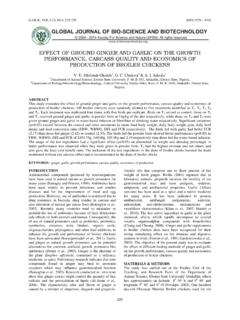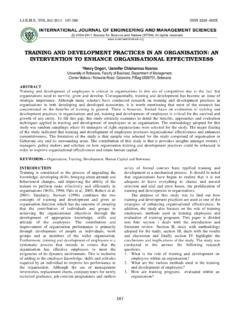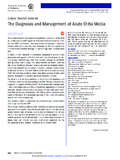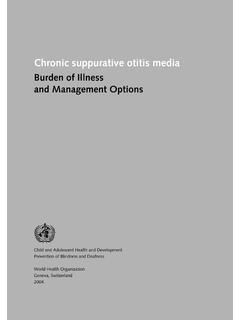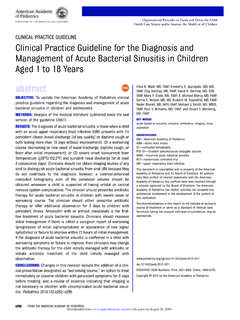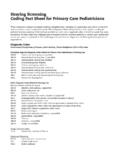Transcription of CLEOME VISCOSA: AN EFFECTIVE MEDICINAL HERB …
1 , (1)2012:153-158 ISSN2229 6441153 CLEOME viscosa : AN EFFECTIVE MEDICINAL HERB FOR OTITISMEDIAJane, R. R. and Patil, S. of Microbiology, Shri Shivaji Science College, Amravati 444603, , INDIAABSTRACTO titis media is one of the most common bacterial infectious diseases among children worldwide and is the leading cause ofmorbidity and mortality in critically ill patients in developing countries. Acetone, chloroform and methanol extracts ofCleome viscosaleaves were investigated for antimicrobial activity against pathogenic bacteria causing otitis media usingdisc diffusion and broth dilution method.
2 Extracts were also evaluated for antioxidant activity using DPPH radical andphytochemicals. Among the organisms testedS. pneumoniaeandE. coliwere most sensitive toacetone extract followed , aeruginosa. EFFECTIVE inhibition zone range of acetone extract was 20-35 mm and MICrange was 4-32 mg/ml. Activity of other extracts was isolate dependent. Radical scavenging activity was 33 % at50 g/mland 21% at 100 g/ml concentration. Phytochemical analysis showed presence of flavonoids, tannins, saponins andalkaloids.
3 The study shows thatCleome viscosamay have potential in the control of otitis media WORDS: MEDICINAL plants, antimicrobial activity, otitis of ear, nose and throat upper respiratory tractaffect the functioning of adults as well as children, oftenwith significant impairment of the daily life of affectedpatients (Witselletal., 2001). Upper respiratory tractinfection includes sore throat, earache, laryngitis, commoncold, sinusitis and otitis media (Sazawal and Black ,2003). otitis media causes inflammation of the middle eardrum and the inner ear (Albert 1999).
4 otitis media is acomplex generic term that includes the acute otitis media (AOM) and otitis media with effusion (OME) (Bowd,2005) is highly prevalent worldwide (Ifante andFernandez, 1993). Over 50 % of the cases of otitis mediacaused by bacteria also fungi, viruses,MycoplasmapneumoniaeandChlamydia trachomatismay cause otitismedia (Block, 1997). otitis media known to be the mostcommon childhood infection which lead annually to deathof over 50,000 children under 5 years (Roverset al.)
5 ,2006). Microbes commonly associated with otitis mediainclude streptococci,staphylococci, Heamophilus,Pseudomonas, Proteusetc (Jokipiiet al., 1977) and arehighly resistant to commonly used antibiotics (Oyeleke,2009).The World Health Organization (WHO, 2002) estimatedthat 80% of populations of developing countries rely ontraditional medicines for their primary health of vast areas and variety of agro-climates inIndia, a large number of MEDICINAL and aromatic plantsfound growing widely and several of these plants havebeen in use for centuries of their MEDICINAL properties(Sahuet al.
6 , 1992). CLEOME viscosaLinn commonly known as "wild or dogmustard," is an annual, sticky herb belonging to familyCapparaceae found as a common weed all over the plainsof India and throughout the tropics of the world. Thewhole plant and its parts (leaves, seeds, and roots) arewidely used in traditional and folkloric systems ofmedicine. In Asia and Africa the leaves and seeds used totreat infections, fever, rheumatism and headache. Thewhole herb is used in treatment of inflammation of themiddle ear and applied on wounds and ulcers.
7 A decoctionis used as an expectorant and digestive stimulant and thevapour from a steaming decoction of the whole plant isinhaled totreat headache (CSIR, 1950). The roots are aremedy for scurvy and rheumatism (Rukmini, 1978). Anaqueous seed extract displayed significant analgesicactivity in mice and local anaesthetic activity in guineapigs (Parimaladeviet al., 2003).MATERIALS AND METHODS1. Collection of plant materialHealthy, disease free and matureCleome viscosaleaveswere collected, washed thoroughly, shade dried and thenpowdered with the help of blender.
8 The powdered materialwas kept in airtight bottles until further use. Theinformation about plant was gathered from traditionalpractitioners, tribal people and Nagarjuna MEDICINAL plantsgarden, Dr. Panjabrao Deshmukh Krishi Vidyapeeth, Preparation of plant extractsDry powdered plant material was extracted inSoxhlet sextractor for 6 hrs or till the plant material gets colourlessusing solvents petroleum ether, chloroform, methanol andacetone. All the extracts were concentrated using rotaryevaporator and dry residue was preserved at 5 C in airtightbottles until further Phytochemical screeningDry residue was dissolved in respective solvents andtested for presence of phytochemicals tannins, alkaloids,flavonoids, of otitis media pathogens byCleome viscosa154 Tannins :To ml of extract solution in acetone, 1 mlof water and 2-3 drops of ferric chloride (FeCl3) wasadded.
9 Blue colour was observed for presence of tannins(Iyenger, 1985).Alkaloids :To ml of extract solutionin acetone,1 mlof 1% HCL was added and warmed the solution. Aftercooling mixture was filtered and treated with few drops ofMayer s reagent. The sample was then observed for thepresence of brown/ red precipitate(Siddiqui and Ali,1997).Saponins ml of extract solution in acetone was addedto distilled water. Presence of frothing in the solutionindicated presence of saponins(Iyenger, 1985).
10 Flavonoids ml of extract solution in acetone wastreated with ml of 50% methanol solution. Thesolution was warmed and metal magnesium was added. Tothis solution, 5-6 drops of concentrated HCl was addedand red colour was observed for flavonoids (Siddiqui andAli, 1997).4. Antioxidant activityAntioxidant activity ofCleome viscosawas measured by2, 2-diphenyl-1-picrylhydrazyl (DPPH) radical-scavengingactivities. The extracts were mixed with methanol to getvarious concentrations: 400, 200, 100, 50, and 10 each concentration, 2 ml of extract was mixed with 1ml of methanolic solution containing DPPH radicals, withfinal concentration of mM DPPH.
